How to Choose A Vector Database: Weaviate Cloud vs. Zilliz Cloud
Compare Weaviate Cloud vs. Zilliz Cloud and Milvus in this in-depth benchmark, cost, and features comparison.
Read the entire series
- Introducing an Open Source Vector Database Benchmark Tool for Choosing the Ideal Vector Database for Your Project
- How to Choose A Vector Database: Elastic Cloud vs. Zilliz Cloud
- How to Choose a Vector Database: Qdrant Cloud vs. Zilliz Cloud
- How to Choose A Vector Database: Weaviate Cloud vs. Zilliz Cloud
- Benchmarking Vector Database Performance: Techniques and Insights
- Developing Custom Applications with Vector Databases
This Weaviate comparison was last updated on October 7, 2024. To provide you with the latest findings, this blog will be regularly updated with the latest benchmark figures.
Not all vector databases are made equal: unveiling the distinction
In the fast paced world of artificial intelligence and machine learning, vector databases have become essential for managing and querying high dimensional data. The last year has seen a big shift as vector search use cases have moved from prototype to production and changed the market dynamics and raised the bar for database performance and scalability. As the demand for these specialized databases grows with real world large scale deployments it’s important to understand not all solutions are created equal. This article will compare two of the main players in the space: Weaviate and Zilliz Cloud, each tackling production scale vector search in very different ways.
Weaviate is an open-source vector database and Zilliz Cloud is a managed service based on open source Milvus, both do vector search and storage. But they are for different use cases.
Weaviate: Strengths in Accessibility and GenAI Integration
Weaviate has positioned itself as an accessible entry point for developers experimenting with vector search technology. Its strengths include:
Developer-friendly approach with a streamlined setup process and well-documented APIs.
Deep integration with the GenAI ecosystem, enabling advanced semantic search capabilities.
Quick implementation, making it suitable for smaller-scale projects or proof-of-concept work.
These features make Weaviate an attractive option for developers seeking rapid deployment and easy integration with AI models.
Weaviate: Considerations for Large-Scale Deployments
However, when considering Weaviate for large-scale, production environments, several factors come into play:
Limited enterprise-grade security features, such as Role-Based Access Control (RBAC) and private networking options.
Scalability challenges due to a tightly coupled architecture, which can make it costly to reshard data for multi-billion vector datasets.
Manual management is required for newly released tiered storage, potentially adding operational complexity.
Primary reliance on the HNSW index, which may limit flexibility in optimizing for diverse use cases involving very large datasets.
Zilliz: Engineered for Scale and Enterprise Needs
In contrast, Zilliz has focused on building a solution optimized for large-scale, high-performance applications:
Highly distributed architecture designed to handle extremely large-scale, high-performance, and low-latency requirements.
Proprietary search engine (Cardinal) and AutoIndex feature, smartly leveraging various index types to balance performance and costs across different use cases.
Comprehensive enterprise features include robust security tools, flexible deployment options, and built-in resiliency.
Tailored compute resources to match specific use case requirements to balance performance and cost.
Automated tiered storage, reducing operational burden while maintaining efficiency and cost-effectiveness.
These features position Zilliz as a robust solution for demanding vector database applications, particularly those requiring enterprise-grade capabilities and scalability to billions of vectors.
We will venture beyond these distinctions within this Weaviate vs. Zilliz Cloud comparison, digging deep into several other comparison areas. We'll delve into benchmarks to offer a performance perspective and perform an in-depth Weaviate Cloud feature analysis.
Benchmarking Weaviate Cloud and Zilliz Cloud
At Zilliz, developers and architects alike ask us, "How does Zilliz measure up to Weaviate Cloud for vector embedding workloads?" This curiosity might spring from various motivations, all stemming from building semantic similarity search for capabilities like product recommenders or reverse image search, and lately, when building LLM applications with Retrieval Augmented Generation (RAG).
Over the past few weeks, we undertook a comprehensive analysis, delving into the performance and attributes of Zilliz Cloud vs. Weaviate Cloud regarding vector embedding workloads. With our open-source benchmark tool, VectorDBBench, our exploration focused intently on critical aspects such as queries per second (QPS), queries per dollar (QP$), and latency.
Datasets tested
We’ve tested two types of datasets to benchmark Zilliz Cloud and Weaviate Cloud.
Dataset 1: 1,000,000 vectors with 768 dimensions
Dataset 2: 500,000 vectors with 1,536 dimensions
Products tested
We’ve tested the following options of Zilliz Cloud and Weaviate Cloud.
Zilliz Cloud (1cu-perf): Zilliz Cloud with one performance-optimized compute unit
Zilliz Cloud (1cu-cap): Zilliz Cloud with one capacity-optimized compute unit
Zilliz Cloud (2cu-cap): Zilliz Cloud with two capacity-optimized compute units
Weaviate Cloud (Standard)
Weaviate Cloud (Business Critical)
Note: For more information about Zilliz Cloud’s compute units, see Zilliz blog introducing Zilliz Cloud CU type.
Queries per second (QPS)
Zilliz provides different hardware options that outperform the standard and business-critical plans of Weaviate Cloud in terms of QPS when processing 1 million vectors with 768 dimensions. Specifically, Zilliz achieves 9x, 8x, and 5x higher QPS than Weaviate Cloud's business plan, which is their best option for QPS.
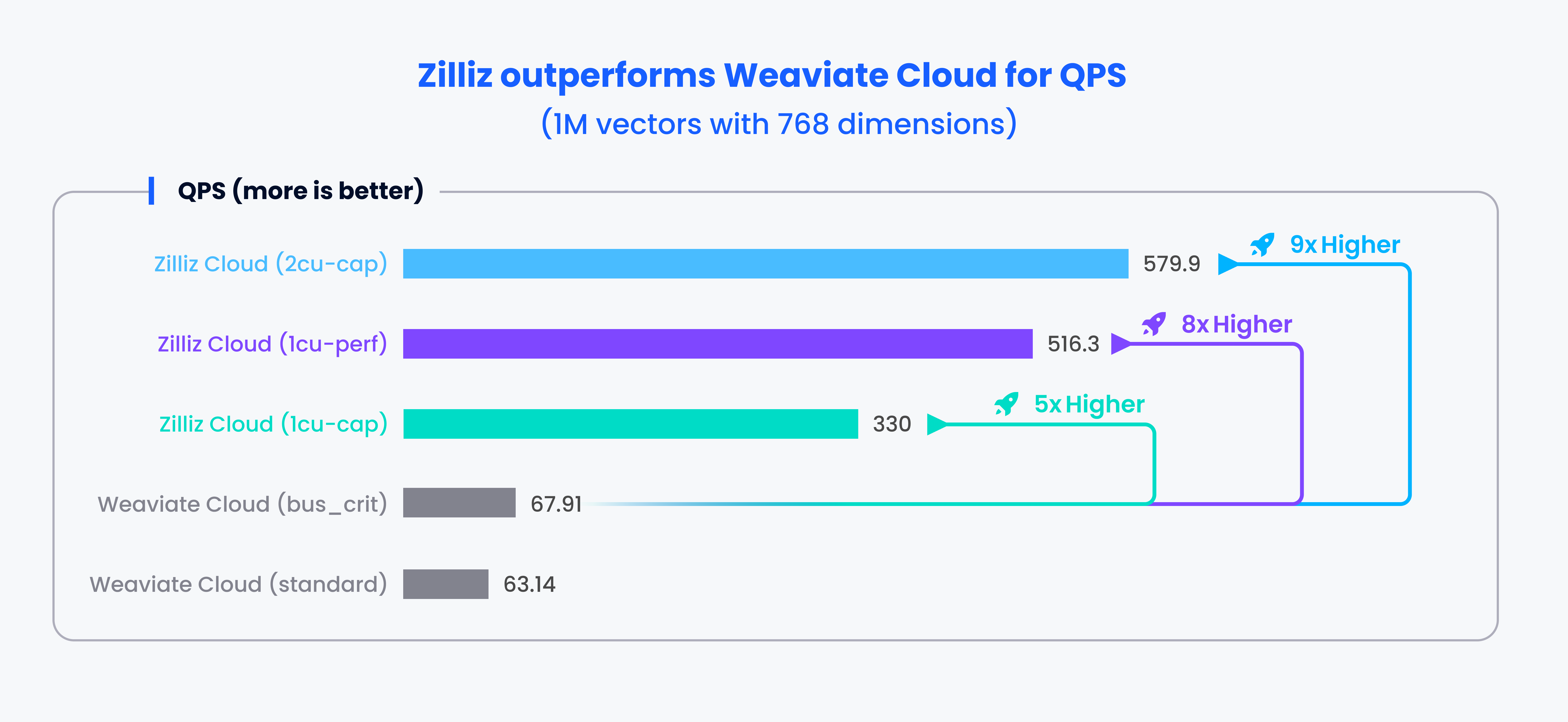
When processing 500,000 vectors with 1,563 dimensions, Zilliz options outperform the standard and business-critical plans of Weaviate Cloud in terms of QPS. Specifically, Zilliz achieves 8x, 6x, and 3x higher QPS than Weaviate Cloud's best option for QPS.
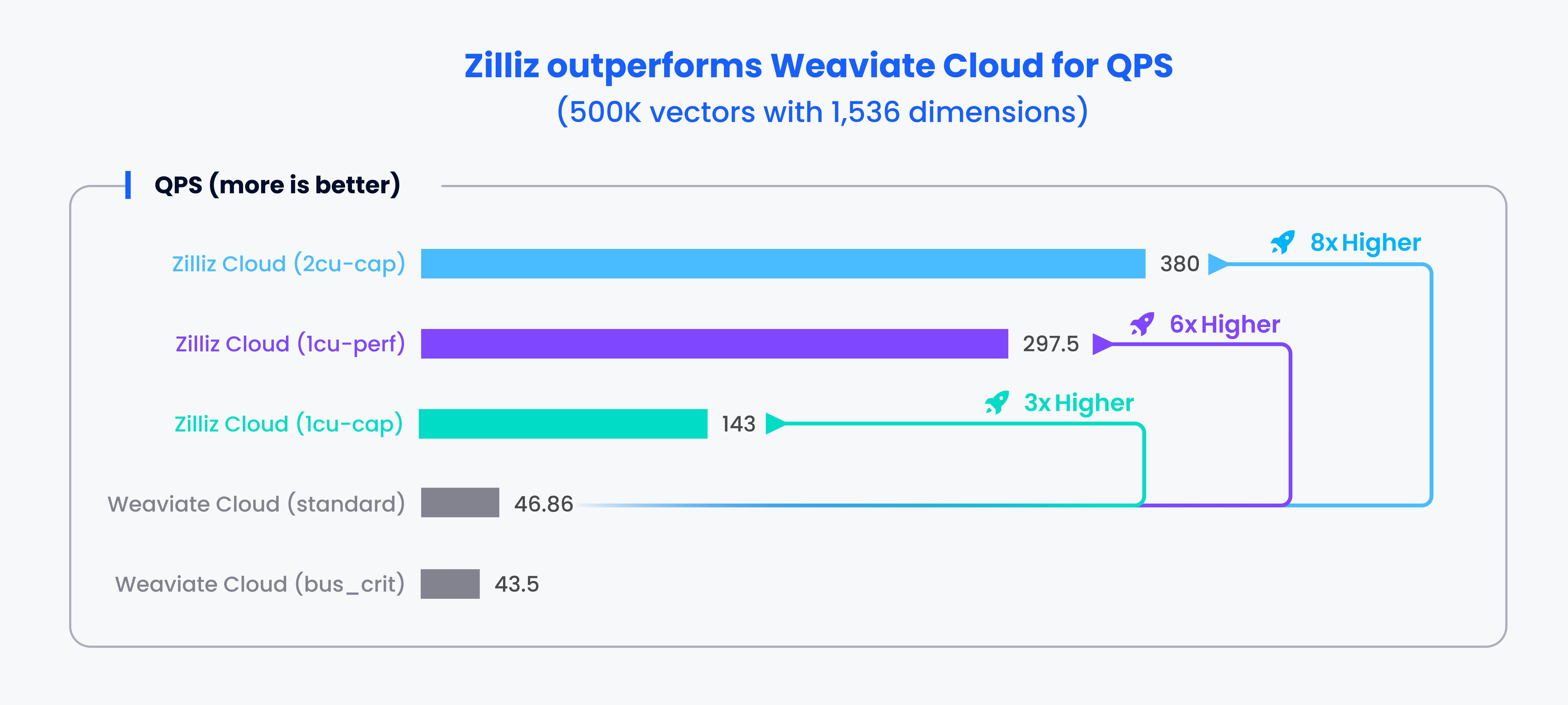
This is a 1-100 score based on each system's performance in different cases according to a specific rule. A higher score denotes better performance.
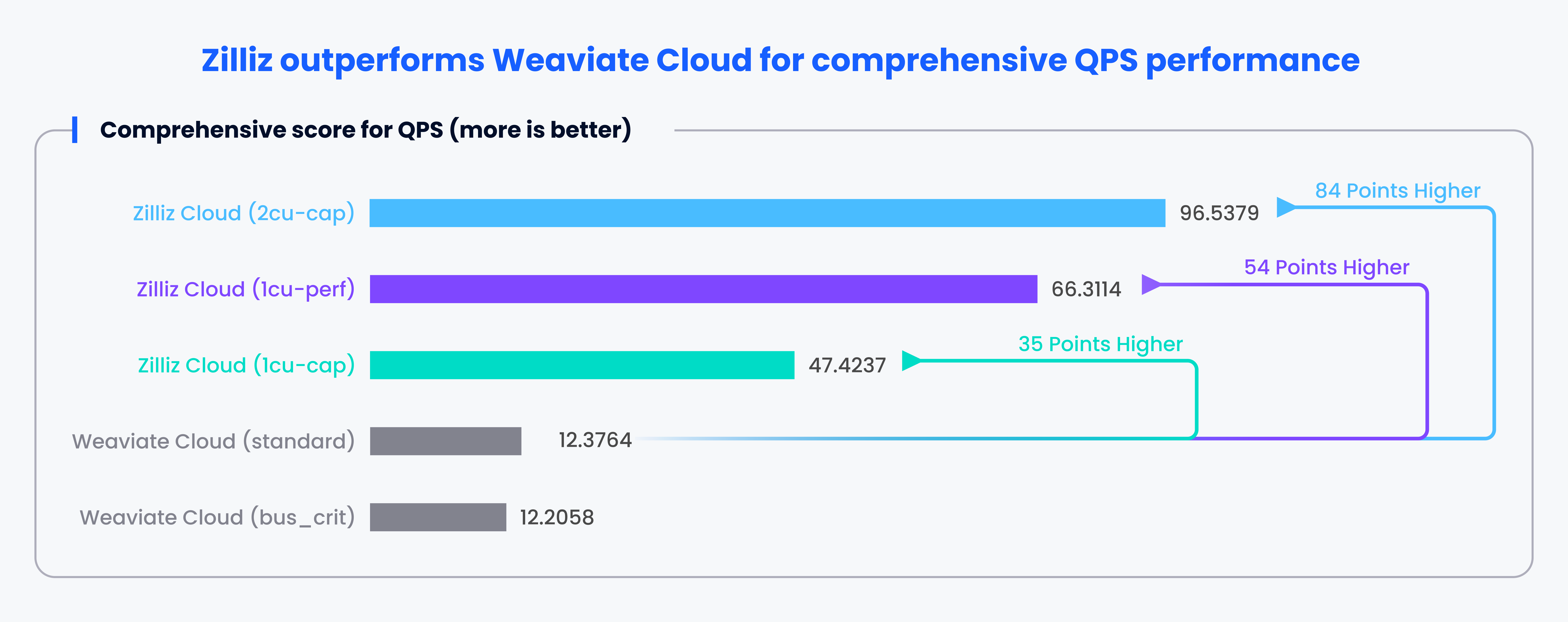
Our tests reveal that Weaviate Cloud's two plans score around 12 points for comprehensive QPS performance, significantly lower than Zilliz's more favorable plan by 84 points and 35 points less than Zilliz's least favorable option.
Queries per $ (QP$)
When processing 1 million vectors with 768 dimensions, all Zilliz options with different hardware resource setups are more efficient than Weaviate Cloud in terms of QP$. Specifically, Zilliz is 520x, 332x, and 292x more cost-effective than Weaviate's standard plan, their best option for QP$.
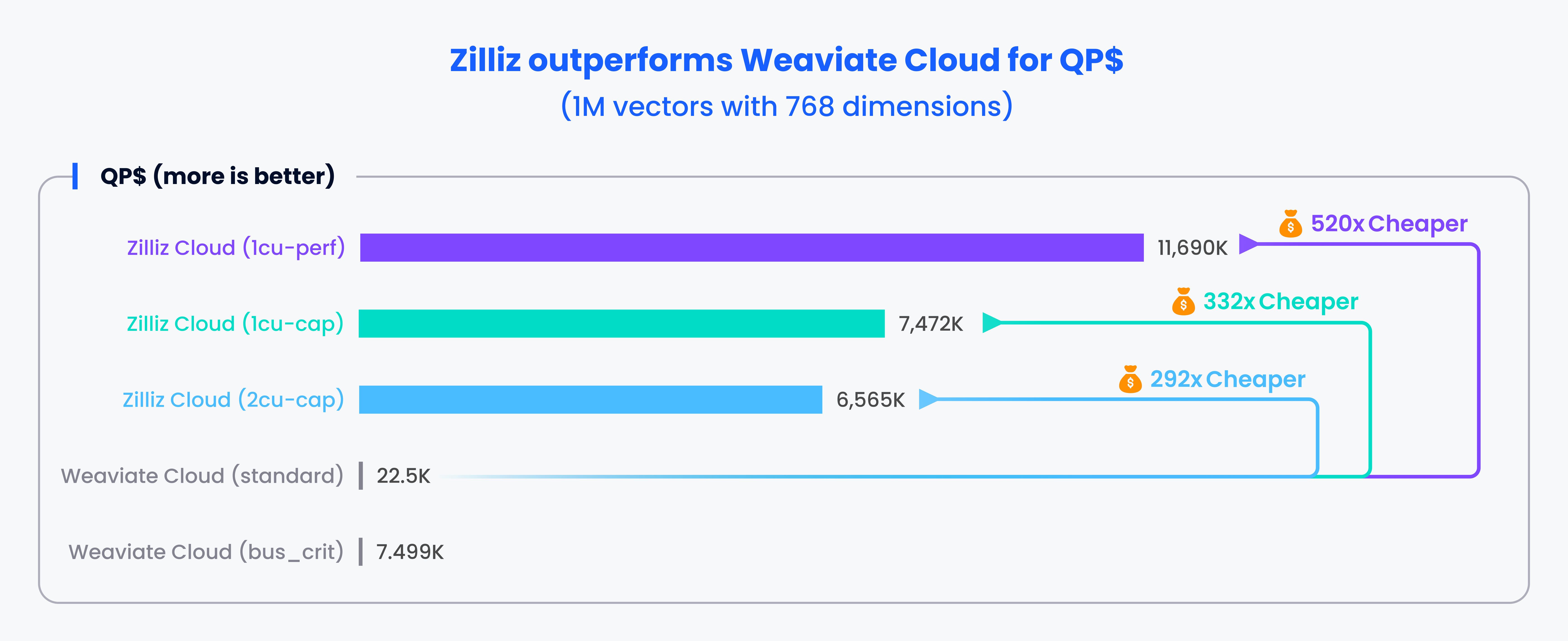
When processing 500,000 vectors with 1,536 dimensions, all Zilliz options with different hardware resource setups are more efficient than Weaviate Cloud in terms of QP$. Specifically, Zilliz is 403x, 258x, and 194x more cost-effective than Weaviate's standard plan, their best option for QP$.
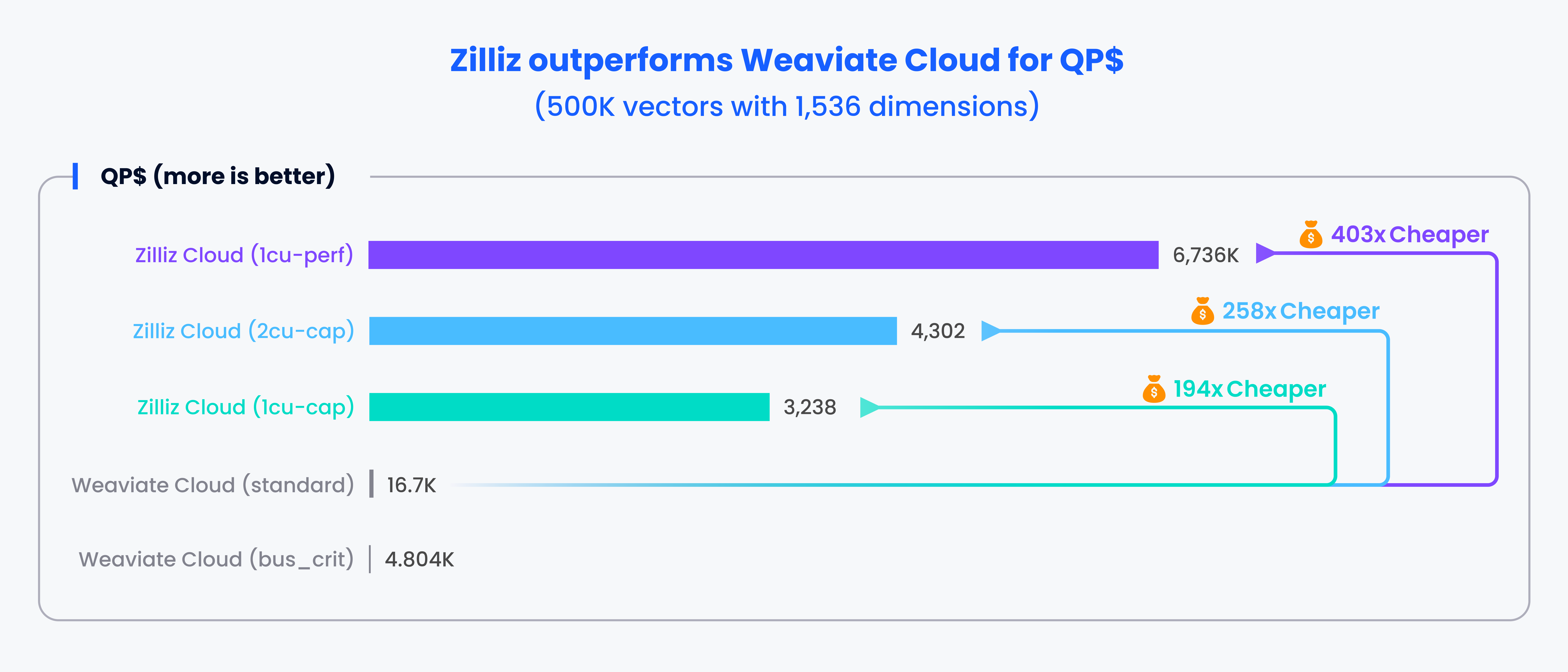
This is a 1-100 score based on each system's performance in different cases according to a specific rule. A higher score denotes better performance.
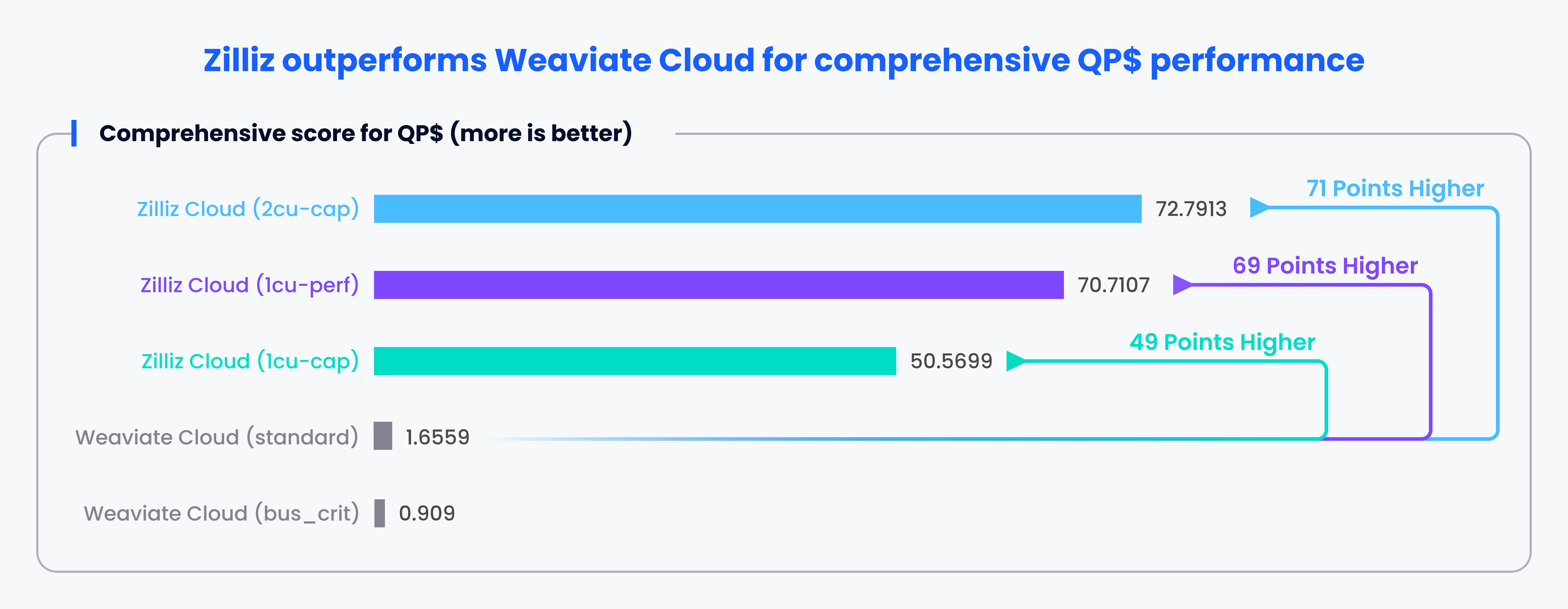
According to our test results, Weaviate's two plans score approximately 1 point for comprehensive QP$ performance, which is significantly lower than Zilliz's most favorable plan by 71 points and 49 points less than Zilliz's least favorable option.
Latency
When processing 1 million vectors with 768 dimensions, all Zilliz options with different hardware resource setups are much faster than Weaviate Cloud in terms of P99 latency. Specifically, Zilliz is 26x, 20x, and 19x faster than Weaviate's business plan, their best option for P99 latency.
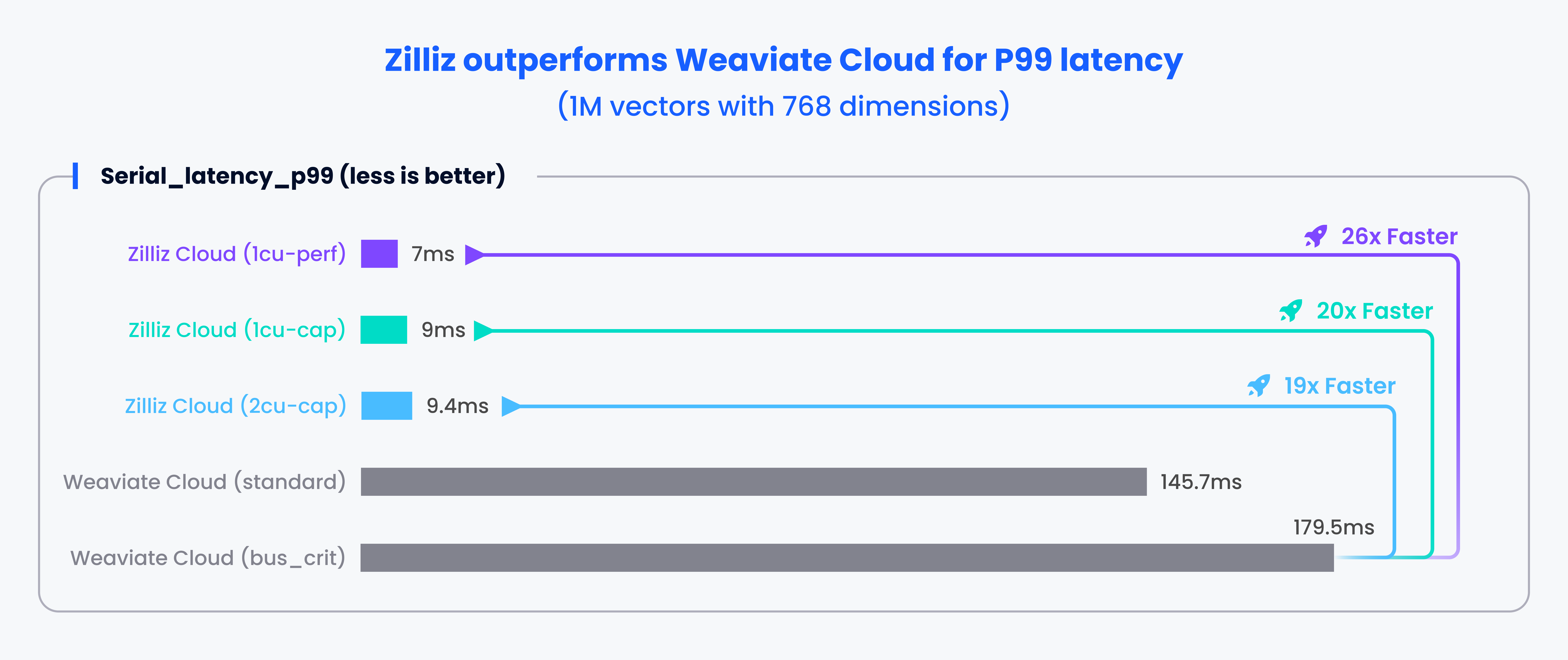
When processing 500,000 vectors with 1,536 dimensions, all Zilliz options with different hardware resource setups are much faster than Weaviate Cloud in terms of P99 latency. Specifically, Zilliz is 32x, 18x, and 7x faster than Weaviate's business plan, their best option for P99 latency.
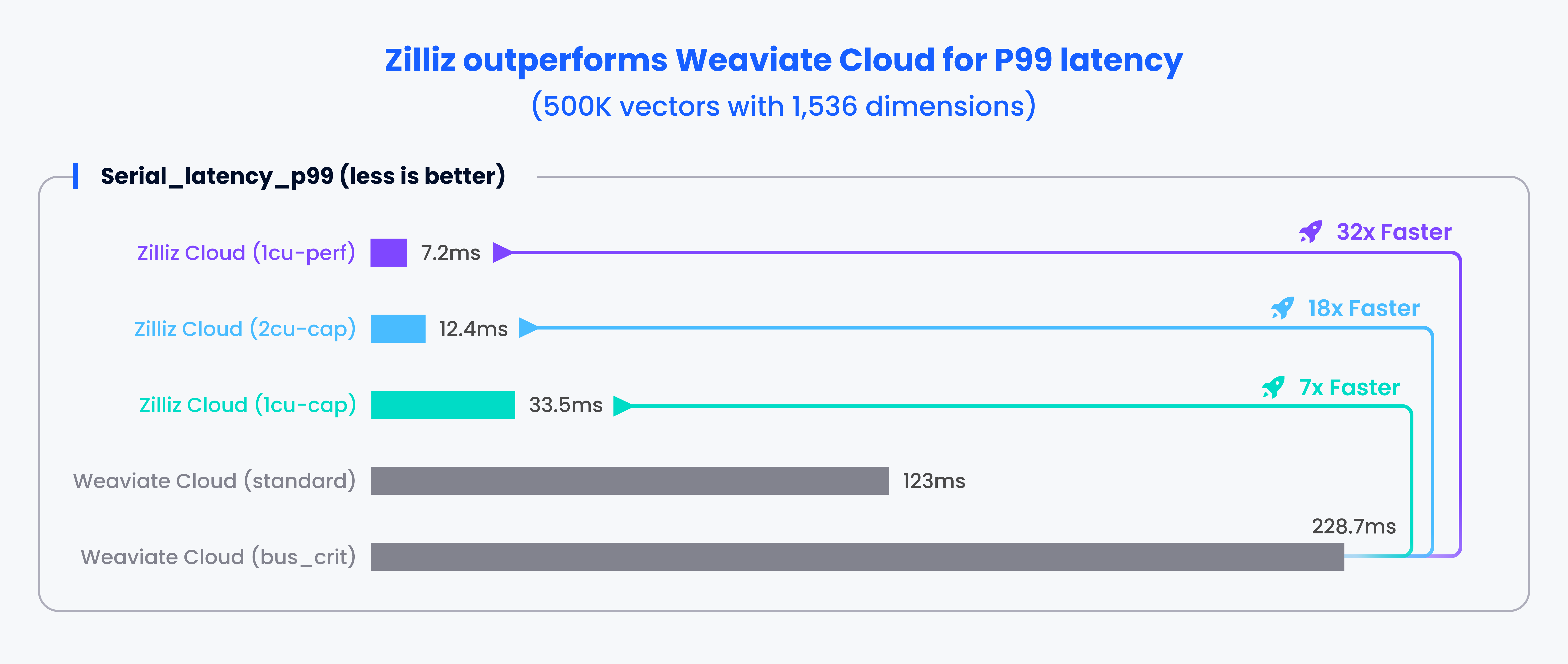
This is a >1 score based on each system's performance in different cases according to a specific rule. A lower score denotes better performance.
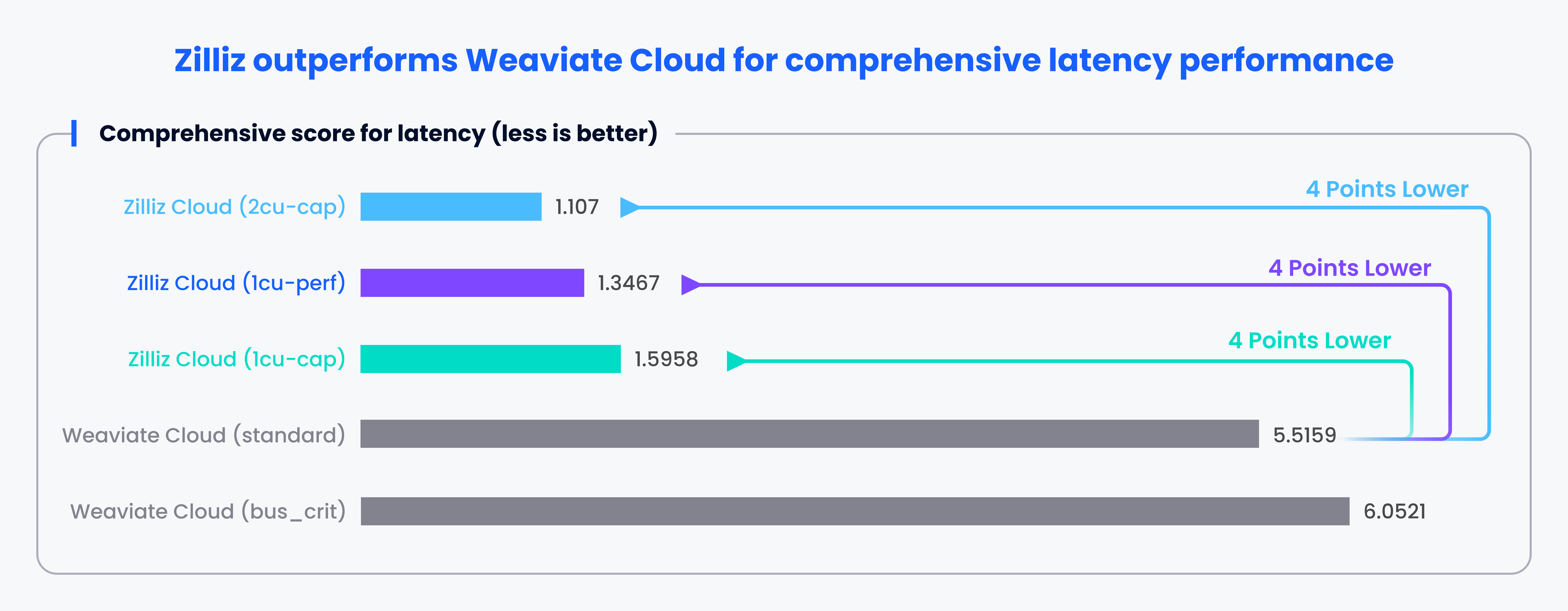
According to our test results, Weaviate Cloud's two plans score approximately 6 points for comprehensive P99 latency performance, which is much higher (slower) than Zilliz Cloud's various options by 4 points.
We conducted these benchmarks using the open-source VectorDB Bench tool on GitHub, where you’ll also find the updated leaderboard. VectorDBBench provides unbiased vector database benchmark results for mainstream vector databases and cloud services. Designed for ease of use, VectorDB Bench makes finding the optimal choice among a plethora of vector database cloud services and open-source vector databases a breeze.
Weaviate Cloud features comparison
Performance is the biggest challenge with vector databases as the number of unstructured data elements stored in a vector database grows into hundreds of millions or billions, and horizontal scaling across multiple nodes becomes paramount. Furthermore, differences in insert rate, query rate, and underlying hardware may result in different application needs, making overall system tunability a mandatory feature for vector databases.
What’s your vector database for?
A vector database is a fully managed solution for storing, indexing, and searching across a massive dataset of unstructured data that leverages the power of embeddings from machine learning models. A vector database should have the following features:
Scalability and tunability
Multi-tenancy and data isolation
A complete suite of APIs
An intuitive user interface/administrative console
Scalability
| Zilliz Cloud | Weaviate Cloud | |
|---|---|---|
| Separation of storage and compute | √ | x |
| Separation of query and insertions | Yes. At the component level (which provides more fine-grained scalability). | No. Only scale at the server level. |
| Multi-replication | √ | √ |
| Billion-scale vector support | √ | √ |
| Dynamic segment placement vs. static data sharding | Dynamic segment placement | Static sharding |
| Multi-tenancy | Enable flexible multi-tenancy through collection and partition management | Enables multi-tenancy through sharding, but resharding is costly |
Vector Search Functionality
| Zilliz Cloud | Weaviate Cloud | |
|---|---|---|
| Disk Index support | √ | x |
| Hybrid Search (ie Scalar filtering) | Yes with multimodal, dense+sparse search | Yes (combine keyword and Dense Vectors) |
| Partitions/namespaces/logical groups | √ | x |
Purpose-built
| Features | Zilliz Cloud | Weaviate Cloud |
|---|---|---|
| Purpose-built for vectors | √ | √ |
| Tunable consistency | √ | √ |
| Support for both stream and batch of vector data | √ | √ |
| Binary vector support | √ | √ |
| Multi-language SDK | Python, Java, Go, C++, Node.js | Python, Java, Go |
Enterprise Readiness
| Zilliz Cloud | Weaviate Cloud | |
|---|---|---|
| Role-based Access Control (RBAC) | √ | x |
| Resiliency Guarantee | 99.95% | 99.9% |
| Compliance & Privacy | SoC 2 Type II, ISO27001, GDPR-ready & HIPPA-ready | SoC 2 Type II |
For more details, visit our Milvus vs Weaviate comparison page.
What’s next?
- Not all vector databases are made equal: unveiling the distinction
- Benchmarking Weaviate Cloud and Zilliz Cloud
- Weaviate Cloud features comparison
- What’s next?
Content
Start Free, Scale Easily
Try the fully-managed vector database built for your GenAI applications.
Try Zilliz Cloud for FreeKeep Reading
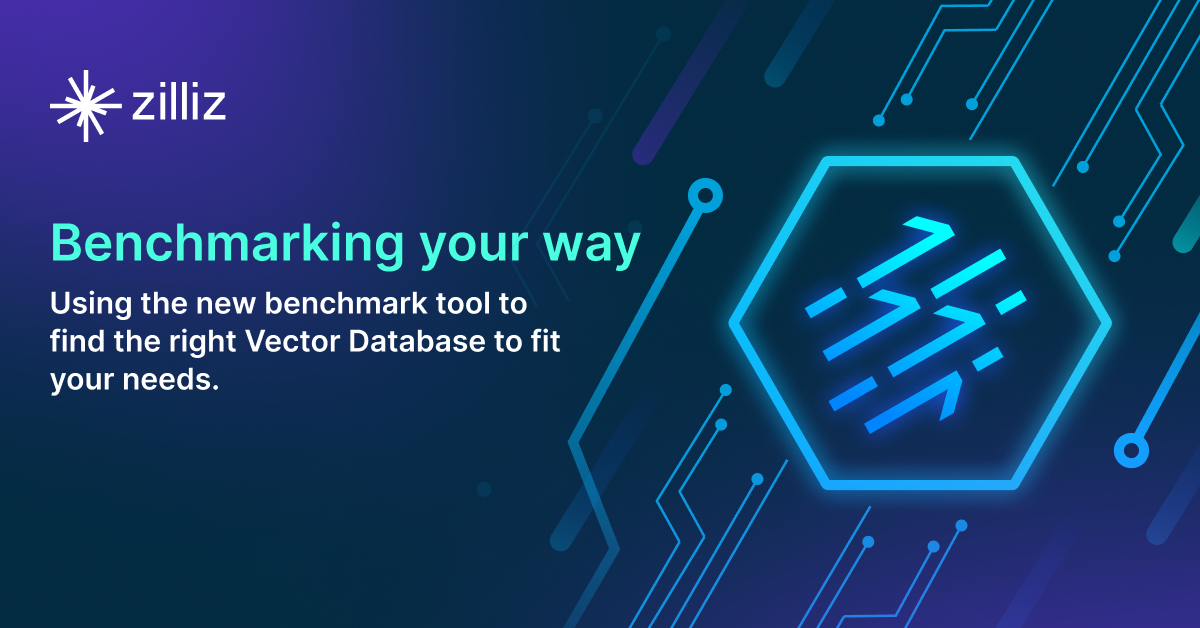
Introducing an Open Source Vector Database Benchmark Tool for Choosing the Ideal Vector Database for Your Project
Introducing VectorDBBench, an open-source vector database benchmark tool for choosing the ideal vector database for your project.
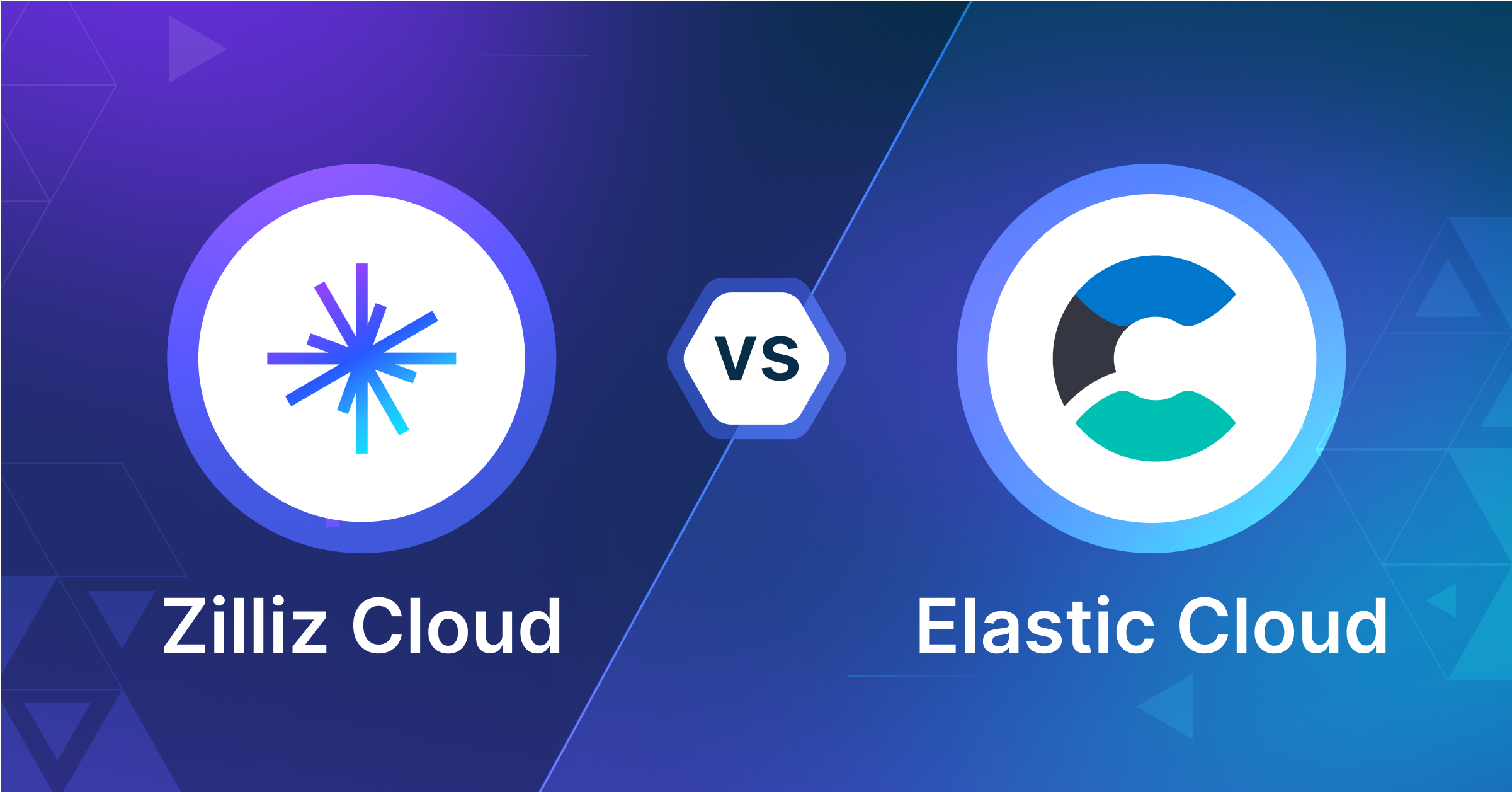
How to Choose A Vector Database: Elastic Cloud vs. Zilliz Cloud
Compare Elastic Cloud vs. Zilliz Cloud in this in-depth benchmark, cost and features comparison.
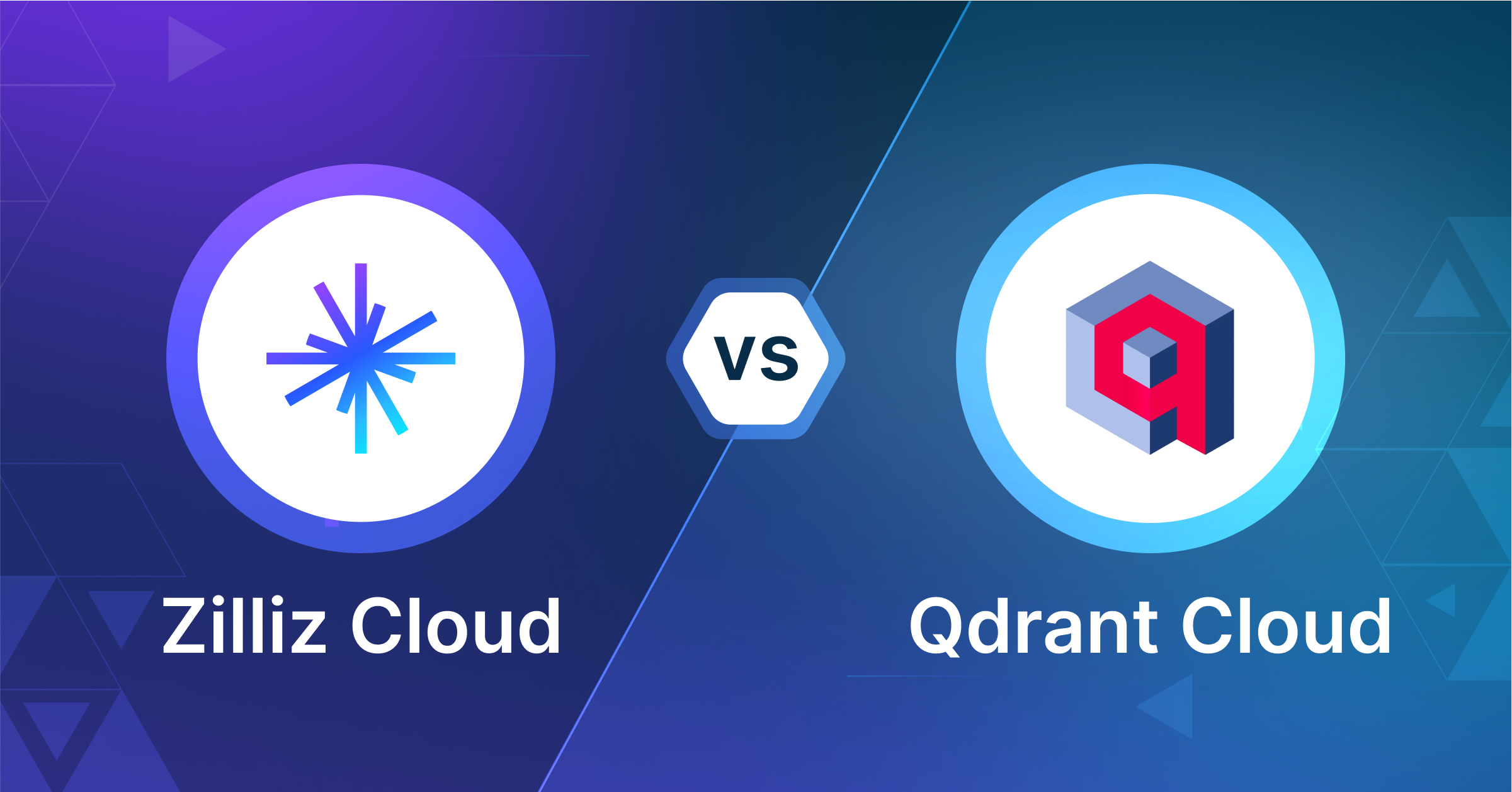
How to Choose a Vector Database: Qdrant Cloud vs. Zilliz Cloud
Compare Qdrant Cloud and Zilliz Cloud (fully managed Milvus) in this in-depth benchmark, cost, and features comparison.
